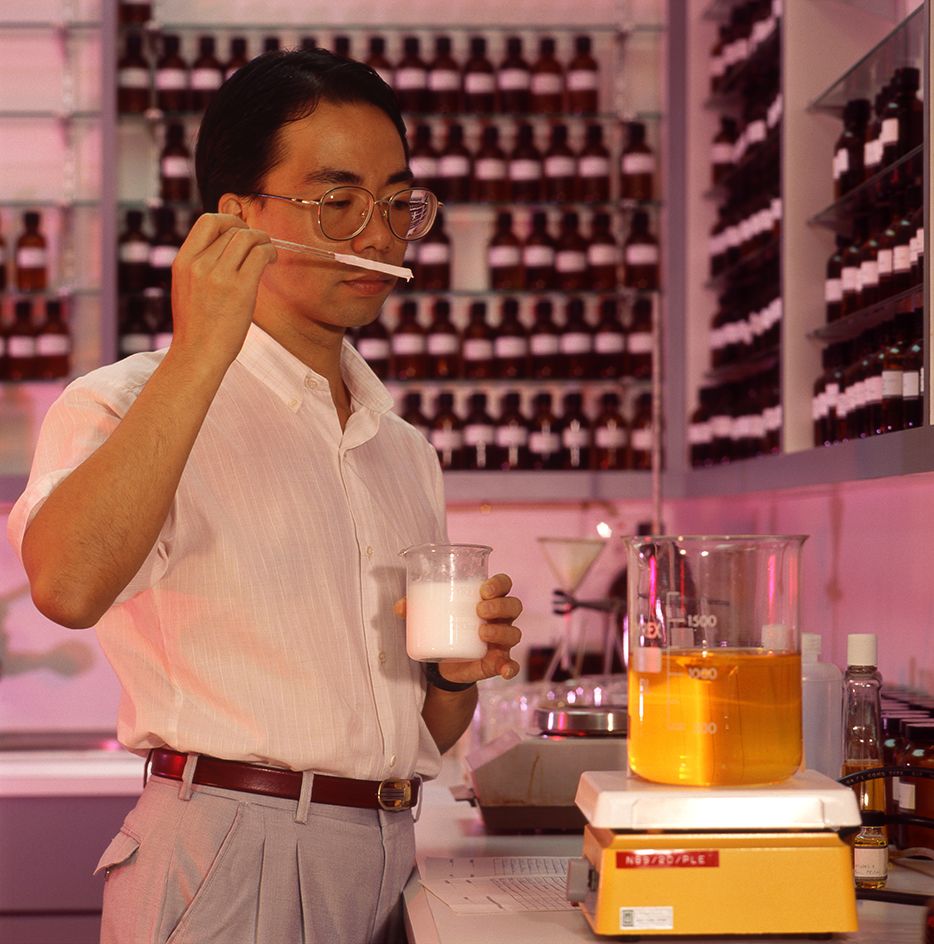Perfume is a substance that gives off a pleasing fragrance. Perfumes are made of natural or synthetic (artificially created) materials, or a combination of both. People who make perfumes are called perfumers.
People use perfumes in many ways to create a pleasant odor. They apply paste and liquid perfumes to their bodies and clothing. They use lipsticks, face and body lotions and powders, and other cosmetics that contain perfume. By far the largest amount of perfume is used in soaps, especially bar soaps, shampoos, and detergents. Industrial odorants (low-priced, scented substances) are added to some products to hide unpleasant odors and make the products attractive to buyers. Paper, plastic, and rubber products are often treated with odorants. Since ancient times, plants and plant products with pleasing odors have been burned as incense during religious services.

Many scented liquids, such as colognes and aftershaves, are sometimes considered to be perfumes. But true perfumes—called extracts, essences, or eau de parfum—contain a greater amount of perfume oils and are more expensive than other scented liquids. Most true perfumes consist of 10 to 20 per cent perfume oils dissolved in alcohol.
Perfumes consist of three basic classes of components called notes. Top notes are the most volatile—that is, they evaporate the quickest. Bottom notes are the least volatile. A typical perfume consists of 45 to 55 percent bottom notes, 30 to 40 percent middle notes, and 15 to 25 percent top notes.
How perfumes are made
The composition of a perfume depends largely on its intended use. Most expensive body perfumes contain rare flower oils from many parts of the world. Perfumes used in soapmaking come from low-cost materials. Industrial odorants also consist mainly of low-cost fragrances. Many perfumes are blends of flower and plant oils, animal substances, synthetics, alcohol, and water.
Plant substances.
Fragrant plants make and store the substances that give them their pleasant odor. These substances are called essential oils. Essential oils taken from flower petals are used in the most delicate and expensive perfumes. Essential oils are also found in other parts of plants. They may come from the bark, buds, fruits, leaves, resins, rinds, roots, seeds, wood, or from whole plants. Plants whose oils are used extensively in perfumes include the cinnamon, citronella, geranium, jasmine, lavender, patchouli, rose, rosemary, sandalwood, and tuberose.
Much essential oil is extracted (obtained) from plants by steam distillation. The first step in this process is to pass steam through the plant material. The essential oil turns to gas, which is then passed through tubing and cooled to make it liquid again. Essential oil is obtained from some flowers by boiling the petals in water, rather than by passing steam through them.
Solvent extraction is an important way of obtaining essential oils from flowers. The petals are dissolved in a solvent (liquid that can dissolve other substances). The solvent is distilled from the solution, leaving a waxy material that contains the oil. This material is placed in ethyl alcohol. The essential oil dissolves in the alcohol and rises with it to the top of the wax. Heat is applied, and the alcohol evaporates, leaving a highly concentrated form of perfume oil called an absolute.
Direct expression involves taking essential oils from the skins of citrus fruits. Pressing the skins squeezes the oil out.
Enfleurage involves using fat to extract flower oils to form a greasy pomade. This method is rarely used today.
Animal substances
come from the scent glands of animals. They slow the evaporation of perfume oils, and make the fragrances long-lasting. For this reason, they are often called fixatives. Perfume ingredients from animals include castor, from the beaver; civet musk, a fatty substance from the civet; musk, from the male musk deer; and ambergris, a waxy substance from the sperm whale.
Synthetic substances
account for the largest amount of materials used in the perfume industry. The raw materials for these substances may be obtained from natural sources, petrochemicals, or coal tar. Some synthetic materials have the same chemical makeup as naturally occurring materials. Others are different from any material found in nature. Many synthetic odors have been developed throughout the world to meet the increasing demand for perfumes and to add to the creative development of the perfume industry.
History
Ancient peoples burned fragrant resins, gums, and woods as incense at their religious ceremonies. The word perfume comes from the Latin words per, meaning through, and fumus, meaning smoke.
Perfumes have been found in the tombs of Egyptian pharaohs (rulers) who lived more than 3,000 years ago. The Egyptians soaked fragrant woods and resins in water and oil, and then rubbed their bodies with the liquid. They also embalmed (preserved) their dead with these liquids. The ancient Greeks and Romans learned about perfumes from the Egyptians.
For hundreds of years, perfume making was chiefly an Oriental art. In the early 1200’s, the crusaders brought perfume from the Middle East to England and France. By the 1500’s, perfumes had become popular throughout Europe. Synthetic chemicals have been used extensively in perfumes since the late 1800’s. Today, the perfume industry is a multibillion-dollar-a-year business worldwide.
